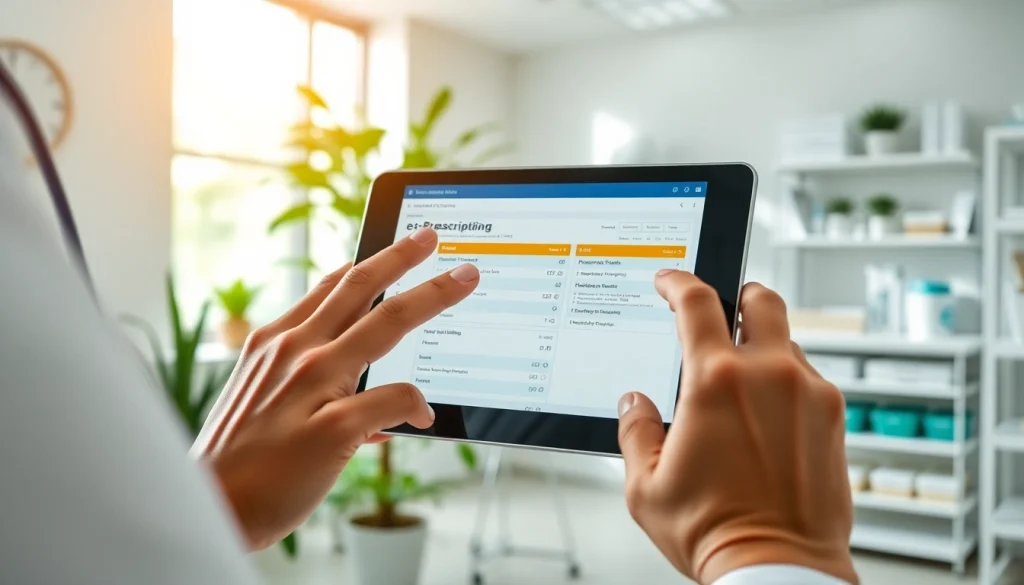Maximizing Efficiency with Eprescription Apps for Android: Key Features and Benefits

Understanding Eprescription Apps for Android
What are Eprescription Apps?
Eprescription apps are digital tools designed for healthcare professionals, enabling them to write, manage, and transmit prescriptions electronically towards pharmacies. These applications facilitate streamlined communication between healthcare providers, pharmacies, and patients, significantly enhancing the prescription process’s efficiency and accuracy. By using eprescription apps for android, physicians can minimize errors associated with handwritten prescriptions and improve patient outcomes.
How Eprescription Apps Transform Healthcare
The advent of e-prescribing has revolutionized healthcare delivery in numerous ways. First and foremost, it reduces the time spent on paperwork, enabling healthcare providers to focus more on patient care. Additionally, the integration of e-prescribing systems within electronic health records (EHR) promotes better medication management, as healthcare professionals can quickly access patient histories, allergies, and other vital information. In doing so, e-prescription apps not only enhance the efficiency of prescription writing but also contribute to improved medication adherence, ultimately leading to better health outcomes.
Key Features of Eprescription Apps for Android
Modern e-prescription apps encompass various useful features designed to support healthcare providers. Key functionalities include:
- Prescription Management: This feature allows providers to efficiently manage multiple prescriptions, track changes, and review past prescriptions.
- Drug Interaction Alerts: Eprescription apps often include safety features that warn prescribers of potential drug interactions, allergies, or contraindications.
- Support for Controlled Substances: Many apps are equipped to handle prescriptions for controlled substances, ensuring compliance with regulatory requirements.
- Real-time Prescription Monitoring: Healthcare providers can monitor prescriptions in real-time, which can help avoid duplicate prescriptions and over-prescribing.
- User-friendly Interfaces: A well-designed user interface allows healthcare professionals to navigate the app effortlessly, enhancing workflow.
Compliance and Security in Eprescription
Understanding HIPAA Regulations
The Health Insurance Portability and Accountability Act (HIPAA) establishes stringent regulations regarding the privacy and security of health information. Eprescription apps must comply with HIPAA guidelines to maintain patient confidentiality and protect sensitive data. This includes ensuring proper encryption methods for data transmission and storage, alongside implementing identity verification processes to limit unauthorized access.
Ensuring Data Security with Eprescription Apps
Data security remains a top priority for healthcare providers utilizing e-prescribing apps. Developers are increasingly incorporating advanced security measures, such as:
- End-to-End Encryption: Encrypting data during transmission protects sensitive information from being intercepted by malicious actors.
- Multi-Factor Authentication (MFA): MFA enhances access security, requiring users to provide multiple forms of verification before accessing the app.
- Regular Security Audits: Implementing frequent audits ensures that potential vulnerabilities are identified and addressed proactively.
Best Practices for Secure Prescription Management
To maximize security within e-prescribing workflows, healthcare providers should adhere to several best practices:
- Train Staff in Security Protocols: Regularly educate staff about data security procedures and internal policies for handling sensitive information.
- Monitor Access Logs: Keeping track of who accesses what information can help identify unauthorized access attempts.
- Implement Regular Software Updates: Staying current with software updates ensures that known security vulnerabilities are addressed promptly.
Choosing the Right Eprescription App for Android
Key Criteria for Selection
When selecting an e-prescribing app, healthcare professionals should consider several essential criteria:
- Usability: The app should provide a clear and intuitive interface for both providers and patients.
- Integration Compatibility: It should seamlessly integrate with existing EHR systems to ensure continuity of care.
- Support and Training: Reliable technical support, training, and resource availability can significantly improve user experience and satisfaction.
Top Recommended Features
Healthcare providers should look for additional features that enhance the overall functionality of e-prescribing apps, including:
- Mobile Accessibility: The app should be fully functional on mobile devices, allowing providers to write prescriptions on the go.
- Pharmacy Network Access: A built-in pharmacy directory enables providers to send prescriptions to patients’ preferred pharmacies directly.
- Patient Communication Tools: Features that facilitate direct communication between providers and patients can improve adherence and understanding of medications.
User Experience and Interface Considerations
The user interface of an e-prescription app plays a crucial role in its adoption and success. Developers should create interfaces that minimize clutter and streamline processes. Usability testing is essential, allowing real users to provide feedback on potential improvements. Ensuring mobile-friendliness is also vital, as many healthcare providers operate in fast-paced environments where access to prescriptions from anywhere can significantly improve efficiency.
Implementation of Eprescription Apps in Practice
Steps to Integrate Eprescription Apps
Implementing e-prescription apps requires a systematic approach that includes the following steps:
- Assessment of Needs: Evaluate the specific needs of the practice, such as volume of prescriptions written, integration with existing systems, and unique workflow requirements.
- Selection of the App: After thorough research and consideration of the criteria mentioned, select an e-prescription app that best fits the practice’s needs.
- Staff Training: Conduct comprehensive training sessions to ensure all staff members understand how to use the app and follow best practices for data security.
- Devise a Rollout Plan: Implement the app incrementally, starting with a pilot program before a full rollout across the practice.
- Monitor and Optimize: Regularly assess the app’s performance and gather user feedback to identify areas for improvement and make necessary adjustments.
Challenges During Implementation
The implementation of e-prescribing apps can come with challenges that practices must navigate effectively. Common issues include:
- Resistance to Change: Some staff may be hesitant to adopt new technology. To overcome this, emphasize the benefits of the app for both providers and patients.
- Technical Difficulties: Address any initial technical issues promptly and ensure ongoing technical support availability during the transition.
- Integration Struggles: Collaborate with IT professionals to ensure seamless integration with existing EHR systems while maintaining data accuracy.
Measuring the Impact of Eprescription Apps
Evaluating the effectiveness of e-prescribing apps is crucial to understanding their impact. Key performance indicators (KPIs) to monitor include:
- Prescription Turnaround Time: Measure how quickly prescriptions are filled from the time they are sent by clinicians to the pharmacy.
- Patient Medication Adherence Rates: Track how well patients adhere to their prescribed medication regimens post-implementation.
- Error Rates: Compare the frequency of prescription errors before and after implementing the app to gauge improvements in prescription safety.
Future Trends in Eprescription Apps for Android
Innovations on the Horizon
The future of e-prescribing apps looks promising with several upcoming innovations such as enhanced data analytics capabilities, allowing healthcare providers to analyze patterns in prescribing behavior. Furthermore, improved interoperability standards may facilitate better data exchange between apps and EHR systems, enhancing care continuity.
Impact of Artificial Intelligence on Eprescription
Artificial intelligence (AI) is anticipated to play a substantial role in the evolution of e-prescribing apps. AI-driven features may include personalized medication suggestions based on patient history or predictive analytics to flag potential drug interactions before prescriptions are written. Such advancements can promote safer prescribing practices and elevate patient care standards.
Enhancing Patient Engagement through Eprescription Apps
Future e-prescription apps will likely place a stronger emphasis on patient engagement by including features that allow patients to track their prescriptions, receive reminders, and access educational materials related to their medications. By empowering patients to be active participants in their healthcare journey, these apps can improve healthcare outcomes and foster a proactive approach to medication management.






